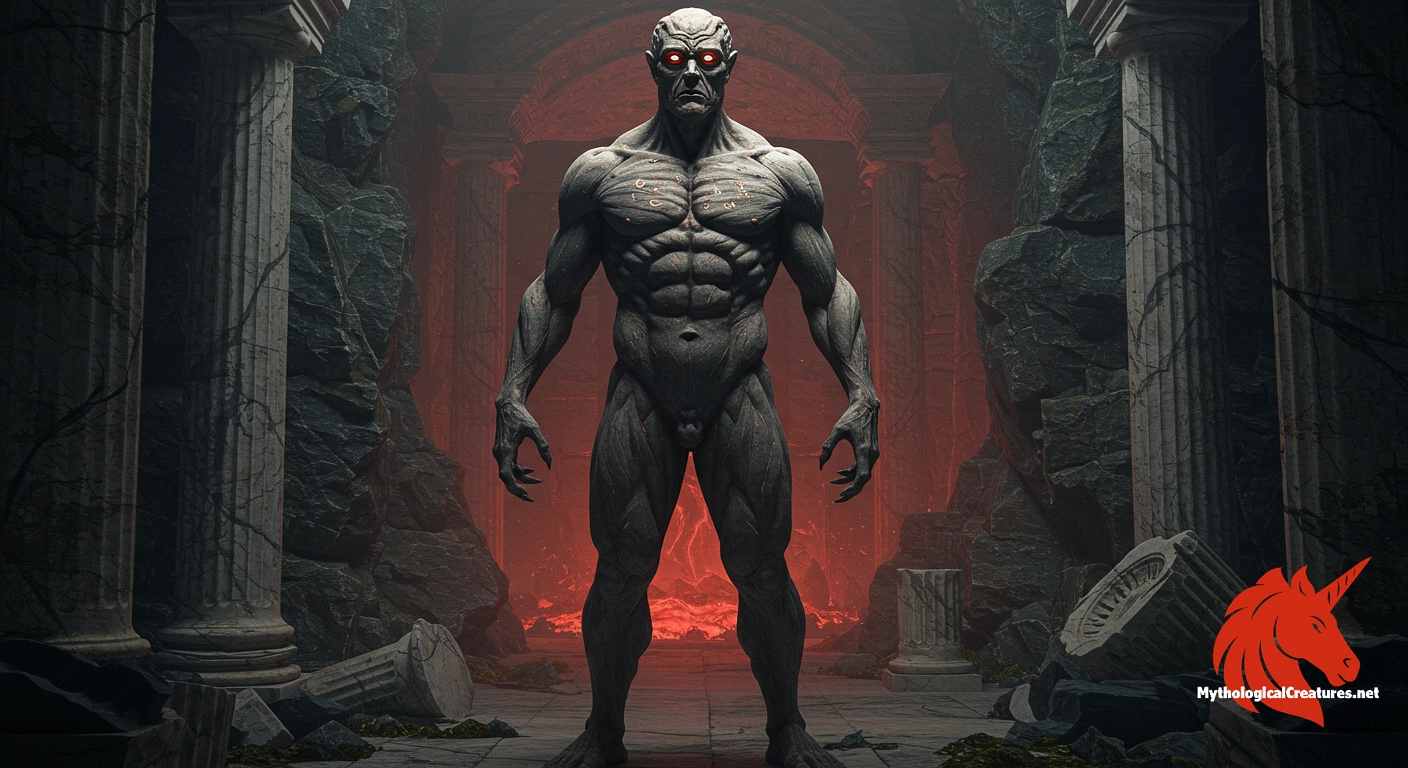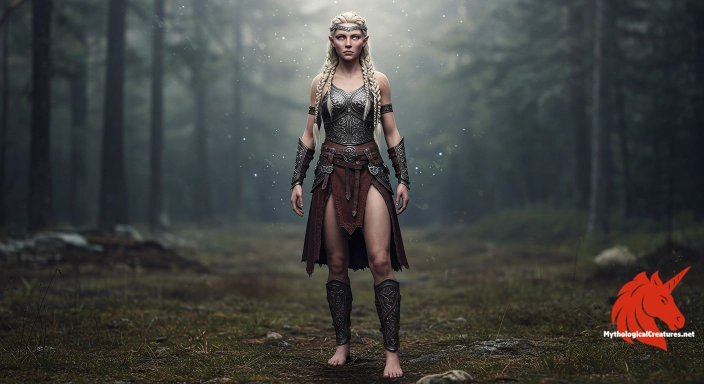Orcus: Orcus is a formidable underworld deity from Etruscan and Roman mythology, revered and feared as the enforcer of oaths.

Orcus
Orcus - Orcus exemplifies the enforcement of moral order and the inevitability of death within ancient mythological belief.
Origins & First Encounters
Orcus is a compelling divine figure emerging from the deep mythological traditions of Roman and Etruscan culture, where his authority was exercised as the punisher of broken oaths. He is intricately linked to the underworld, a realm whose very name became synonymous with his own dark domain. His origins appear to be rooted in ancient practices that revered both divine retribution and the sanctity of promises, intertwining human ethics with celestial justice. Early depictions highlight his association with the enforcement of moral order, where even minor breaches of trust were met with his formidable presence. The earliest attestations suggest that his character was adapted from the Greek daemon Horkos, blending indigenous beliefs with Hellenic influences. His reputed temple on Rome’s Palatine Hill further illustrates the importance accorded to his function in local spirituality. Over time, his identity merged with other deities of the underworld, reflecting a rich tapestry of religious syncretism. His narrative encapsulates the timeless human preoccupation with retribution and the maintenance of social order. The enduring mystery surrounding his figure continues to intrigue modern audiences, inviting a re-examination of ancient values and divine authority.
Source Texts & Tale Variants
The surviving accounts of Orcus are derived from fragmented ancient texts and archaeological echoes that hint at his formidable role as an enforcer of oaths. Despite the limited volume of detailed literature, inscriptions and temple remnants suggest he was central to rituals that underscored the inviolability of promises. Early Roman records, though sparse, vividly portray him as a stern adjudicator whose interventions preserved ethical conduct. Variants of his story appear in local cult practices where regional narratives subtly adjusted his character to fit different societal norms. Some sources maintain a clear focus on his function as an oath punisher, while others amalgamate his traits with broader notions of the underworld and divine judgement. The transliteration from the Greek daemon Horkos further adds complexity to his mythic origins, blending two distinct religious traditions into a single formidable identity. Diverse narrative strands indicate that his story was often recontextualised to meet evolving cultural needs, thus preserving his relevance across generations. The comparative scarcity of primary texts does not diminish the impact of his legend, which has been sustained by both literary and ritualistic traditions. These multiple strands collectively offer a tantalising glimpse into a god whose myth underwent continual reinterpretation in the ancient world.
Form & Powers
Artistic and literary depictions of Orcus, though relatively rare, evoke a figure of grim authority and otherworldly power. He is often imagined as a towering presence cloaked in dark, flowing garments that mirror the endless shadows of the underworld. His face is portrayed with a stern and implacable expression, the deep-set eyes conveying both the weight of judgement and a profound sorrow. In various representations, his pallid complexion and somber features symbolise his intimate connection with death and the afterlife. Iconographic fragments suggest that he might have been depicted wielding a scepter or rod, emblematic of his authority to mete out divine retribution. The interplay of light and dark in his portrayals often highlights his role as both a guardian of moral order and a harbinger of inevitable decay. Some ancient artworks emphasise a robust and imposing stature, reinforcing his status as a powerful overseer of cosmic balance. Although definitive physical descriptions remain elusive, the cumulative imagery underscores a synthesis of human vulnerability and divine severity. Each artistic interpretation contributes to a layered portrayal of Orcus, merging tangible human features with the abstract terror of the nether realms.
Regional Faces
The perception of Orcus varied considerably across different regions, reflecting the rich diversity of local traditions and worship practices. In Etruscan lore, he is interwoven with the broader cosmological themes of fate and the afterlife, where moral failings were met with supernatural consequences. Roman adaptations of his myth saw him increasingly blended with other underworld deities like Pluto and Dis Pater, creating a composite figure that encapsulated various aspects of death and retribution. Local cults often retained unique elements of his original identity, emphasising his role specifically as the dispenser of justice for broken oaths. In certain regions, folk traditions maintained the memory of his wrath, portraying him as a spectral guardian who patrolled the boundary between the living and the dead. These regional adaptations were enriched by indigenous beliefs and local customs, allowing for a more nuanced interpretation of his divine function. The evolution of his worship practices reflects the adaptability of myth in addressing the distinct social and ethical concerns of different communities. Through regional variations, the figure of Orcus remained relevant as a symbol of order and a deterrent against moral transgression. Such localised narratives continue to shed light on how ancient societies interwove divine retribution with everyday life.
Cultural Parallels
Orcus shares striking thematic similarities with other deities of the underworld across various mythologies, positioning him within a broader global tradition of cosmic justice. His role as the punisher of oath-breakers aligns him with the retributive characteristics seen in figures such as Pluto and Hades, although he is distinguished by his specific focus on the sanctity of promises. The confluence of his myth with that of Dis Pater illustrates the tendency for deities to merge as cultures evolve, blending functions related to death and moral enforcement. Comparisons can also be drawn with the Greek personification of oaths, providing insight into how diverse cultures articulated the consequences of betrayal and dishonesty. Despite differences in cultural context, these deities collectively emphasise the universal principle that moral transgressions invite divine retribution. In studying such parallels, one observes that the archetype of a divine arbiter of justice is a recurring motif throughout world mythologies. Each tradition imbues its respective figure with traits that reflect its unique ethical concerns, yet the underlying narrative remains remarkably consistent. These cross-cultural connections highlight how sacred themes of duty and punishment transcend geographical and temporal boundaries. Ultimately, Orcus embodies a potent symbol of the human insistence on honour and the inexorable nature of moral law, resonating with mythical figures from a variety of cultures.
Legacy & Modern Evolution
The evolution of Orcus’s myth reveals a dynamic interplay between ancient belief systems and later reinterpretations in art and literature. Originally revered as a potent enforcer of moral codes, his distinct identity gradually fused with broader representations of the underworld as deities like Pluto and Dis Pater came to dominate the mythological landscape. This process of syncretism diluted some of his individualistic traits while simultaneously enriching the collective imagery of divine retribution. Through the Renaissance and beyond, artistic depictions began to revisit these archaic themes, often casting Orcus in roles that emphasise the inexorable nature of justice. Modern fantasy literature and role-playing games have reimagined him as an embodiment of cosmic law and as a character whose fearsome presence underscores the inevitable consequences of ethical breaches. Contemporary media reinterprets his legacy not only as a relic of ancient superstition but also as a profound metaphor for the intersection between duty and destiny. Academic explorations into his myth have further illuminated the complex ways in which religious figures adapt to shifting cultural paradigms. The persistent allure of his narrative continues to inspire debate and creative reinterpretation among scholars and enthusiasts alike. In this modern resurgence, Orcus remains a testament to the enduring power of myth in encapsulating the human struggle with morality and the unknown.
Interesting Fact
Orcus uniquely bridges the realms of death and justice, acting both as the embodiment of the underworld and as the ultimate arbiter of oath-keeping in ancient myth.
Quick Creature Info
Origin:
Features:
Associations:
Our Mythic Legendary Rating:

Also Sometimes Known As:
Habitat:
Supernatural Powers:
Physical Attributes:
Abilities:
Behavior:
Weaknesses:
Lore:
Related Creatures, Tales or Lore
- HHades
- PPluton
- DDis Pater
References
Discover Another Mythical Legend You May Not Have Heard Of?
Uncover the mysteries of ancient folklore and expand your knowledge of legendary beings from cultures around the world.
Dare to Meet the Hervör alvitr....
Mythical Disclaimer: The images and data on this site are derived from various historical and literary sources, but we have found that many myths often have multiple versions and interpretations across references, sometimes contradictory. As a result, these creature depictions are artistic interpretations—imaginative blends of folklore, legend, and a dash of AI guesswork. Because creature descriptions vary widely, our illustrations and accompanying information represent our best effort to honor mythology while bridging creative gaps. Enjoy these interpretations—just remember, we've done our best to respect the stories and validate available data, but in the realm of mythology, details often shift, imagination leads the way, and nothing is ever set in stone!
Curated by the Mythological Creatures Team (rev. May 2025)
